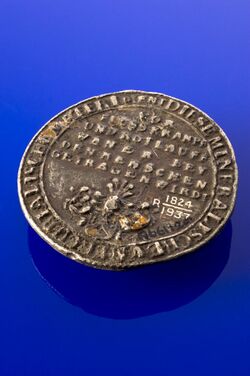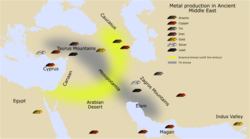Metals of antiquity
Topic: Chemistry
 From HandWiki - Reading time: 5 min
From HandWiki - Reading time: 5 min
The metals of antiquity are the seven metals which humans had identified and found use for in prehistoric times in Africa, Europe and throughout Asia:[1] gold, silver, copper, tin, lead, iron, and mercury. These seven are the metals from which the classical world was forged.
Zinc, arsenic, and antimony were also known during antiquity, but they were not recognised as distinct metals until later.[2][3][4][5] A special case is platinum; it was known to native South Americans around the time Europe was going through classical antiquity, but was unknown to Europeans until the 18th century. Thus, at most eleven elemental metals and metalloids were known by the end of antiquity; this contrasts greatly with the situation today, with over 90 elemental metals known.
Bismuth only began to be recognised as distinct around 1500 by the European and Incan civilisations. The first elemental metal with a clearly identifiable discoverer is cobalt, discovered in 1735 by Georg Brandt, by which time the Scientific Revolution was in full swing.[6] (Even then, cobalt might have been prepared before the 13th century by alchemists roasting and reducing its ore, but in any case its distinct nature was not recognised.)[7]
Characteristics
Melting point
The metals of antiquity generally have low melting points, with iron being the exception.
- Mercury melts at −38.829 °C (−37.89 °F)[8] (being liquid at room temperature).
- Tin melts at 231 °C (449 °F)[8]
- Lead melts at 327 °C (621 °F)[8]
- Silver at 961 °C (1763 °F)[8]
- Gold at 1064 °C (1947 °F)[8]
- Copper at 1084 °C (1984 °F)[8]
- Iron is the outlier at 1538 °C (2800 °F),[8] making it far more difficult to melt in antiquity. Cultures developed ironworking proficiency at different rates; however, evidence from the Near East suggests that smelting was possible but impractical circa 1500 BC, and relatively commonplace across most of Eurasia by 500 BC.[9] However, until this period, generally known as the Iron Age, ironwork would have been impossible.
The other metals discovered before the Scientific Revolution largely fit the pattern, except for high-melting platinum:
- Bismuth melts at 272 °C (521 °F)[8]
- Zinc melts at 420 °C (787 °F),[8] but importantly boils at 907 °C (1665 °F), a temperature below the melting point of silver. Consequently, at the temperatures needed to reduce zinc oxide to the metal, the metal is already gaseous.[10][11]
- Arsenic sublimes at 615 °C (1137 °F), passing directly from the solid state to the gaseous state.[8]
- Antimony melts at 631 °C (1167 °F)[8]
- Platinum melts at 1768 °C (3215 °F), even higher than iron.[8] Native South Americans worked with it instead by sintering: they combined gold and platinum powders, until the alloy became soft enough to shape with tools.[12][13]
Extraction
While all the metals of antiquity but tin and lead occur natively, only gold and silver are commonly found as the native metal.
- Gold and silver occur frequently in their native form
- Mercury compounds are reduced to elemental mercury simply by low-temperature heating (500 °C).
- Tin and iron occur as oxides and can be reduced with carbon monoxide (produced by, for example, burning charcoal) at 900 °C.
- Copper and lead compounds can be roasted to produce the oxides, which are then reduced with carbon monoxide at 900 °C.
- Meteoric iron is often found as the native metal and it was the earliest source for iron objects known to humanity
Rarity
While widely known during antiquity, most of these metals are by no means common.
- Iron is the 4th-most abundant element in the Earth's crust (approximately 50,000ppm, or 4.1% by mass)
- Copper is next at 26th (50ppm)
- Lead is 37th (14ppm)
- Tin is 49th (2.2ppm)
- Silver is 65th (70ppb)
- Mercury is 66th (50ppb)
- Gold is the 72nd (1.1ppb)
Yet all were known and available in tangible quantities in ancient times.
Additionally, despite being approximately 1,000 times more abundant in the crust than the next most abundant ancient metal, iron was the last to become available due to its melting point (see above), including requiring tools made from alloys such as bronze to work in quantity. Other comparably abundant elements, such as titanium (approximately 4,400ppm) and aluminium (approximately 83,000ppm),[14] were not available until the modern era. This was due almost entirely to the huge quantities of energy required to purify ores of these elements. Energy requirements and tool availability were, therefore, the primary limiting factors affecting an ancient civilisation's ability to access metals, rather than those metals' relative abundances.
Symbolism
The practice of alchemy in the Western world, based on a Hellenistic and Babylonian approach to planetary astronomy, often ascribed a symbolic association between the seven then-known celestial bodies and the metals known to the Greeks and Babylonians during antiquity. Additionally, some alchemists and astrologers believed there was an association, sometimes called a rulership, between days of the week, the alchemical metals, and the planets that were said to hold "dominion" over them.[15][16] There was some early variation, but the most common associations since antiquity are the following:
| Metal | Body | Symbol | Day of week |
|---|---|---|---|
| Gold | Sun | ☉︎ | Sunday |
| Silver | Moon | ☾ | Monday |
| Iron | Mars | ♂ | Tuesday |
| Mercury | Mercury | ☿ | Wednesday |
| Tin | Jupiter | ♃ | Thursday |
| Copper | Venus | ♀ | Friday |
| Lead | Saturn | ♄ | Saturday |
See also
- Timeline of chemical element discoveries
- Ashtadhatu, the eight metals of Hindu alchemy (these seven plus zinc)
- History of metallurgy in the Indian subcontinent
- History of metallurgy in China
- Metallurgy in pre-Columbian America
- Copper metallurgy in Africa
- Iron metallurgy in Africa
References
- ↑ Smith, Cyril Stanley; Forbes, R.J. (1957). "2: Metallurgy and Assaying". in Singer. A History Of Technology. Oxford University Press. p. 29.
- ↑ Moorey, P. R. S. (1994). Ancient Mesopotamian Materials and Industries: the Archaeological Evidence. New York: Clarendon Press. p. 241. ISBN 978-1-57506-042-2. https://books.google.com/books?id=P_Ixuott4doC&pg=PA241.
- ↑ Healy, John F. (1999). Pliny the Elder on Science and Technology. Oxford University Press. ISBN 9780198146872. https://books.google.com/books?id=Hz6D4H-s5psC. Retrieved 26 January 2018.
- ↑ Holmyard, Eric John (1957). Alchemy. Courier Corporation. ISBN 9780486262987. https://books.google.com/books?id=7Bt-kwKRUzUC. Retrieved 26 January 2018.
- ↑ Biswas, Arun Kumar (1993). "The Primacy of India in Ancient Brass and Zinc Metallurgy". Indian Journal of History of Science 28 (4): 309–330. https://cahc.jainuniversity.ac.in/assets/ijhs/Vol28_4_3_AKBiswas.pdf. Retrieved 4 January 2024.
- ↑ Miśkowiec, Paweł (2022). "Name game: the naming history of the chemical elements—part 1—from antiquity till the end of 18th century". Foundations of Chemistry 25: 29–51. doi:10.1007/s10698-022-09448-5.
- ↑ Weeks, Mary Elvira (1960). Discovery of the Elements (6th ed.). Journal of Chemical Education. p. 153.
- ↑ 8.00 8.01 8.02 8.03 8.04 8.05 8.06 8.07 8.08 8.09 8.10 8.11 Winter, Mark. "The periodic table of the elements by WebElements". https://www.webelements.com/.
- ↑ Erb-Satullo, Nathaniel L. (December 2019). "The Innovation and Adoption of Iron in the Ancient Near East". Journal of Archaeological Research 27 (4): 557–607. doi:10.1007/s10814-019-09129-6.
- ↑ Alam, Ishrat (2020). "The history of zinc and its use in pre-modern India". Studies in People's History 7 (1). doi:10.1177/2348448920908237. https://journals.sagepub.com/doi/10.1177/2348448920908237. Retrieved 4 January 2024.
- ↑ Li, Yuniu; Xiao, Birui; Juleff, Gill; Huang, Wan; Li, Dadi; Bai, Jiujiang (2020). "Ancient zinc smelting in the Upper and Middle Yangtze River region". Antiquity 94 (375). doi:10.15184/aqy.2020.83.
- ↑ Bergsøe, Paul (1936). "Metallurgy of Gold and Platinum among the Pre-Columbian Indians". Nature (Springer Science and Business Media LLC) 137 (3453): 29. doi:10.1038/137029a0. ISSN 0028-0836. Bibcode: 1936Natur.137...29B.
- ↑ Meeks, N.; La Niece, S.; Estevez, P. (2002). "The technology of early platinum plating: a gold mask of the La Tolita culture, Ecuador". Archaeometry (Wiley) 44 (2): 273–284. doi:10.1111/1475-4754.t01-1-00059. ISSN 0003-813X.
- ↑ Darling, David. "terrestrial abundance of elements". http://www.daviddarling.info/encyclopedia/E/elterr.html.
- ↑ Ball, Philip (2007). The Devil's Doctor: Paracelsus and the World of Renaissance Magic and Science. London: Arrow. ISBN 978-0-09-945787-9.
- ↑ Kollerstrom, Nick. "The Metal-Planet Relationship: A Study of Celestial Influence". http://homepages.ihug.com.au/~panopus/metalplanet/metalplanet.htm.
- "History of Metals". Archived from the original on 2007-01-08. https://web.archive.org/web/20070108015008/http://neon.mems.cmu.edu/cramb/Processing/history.html.
- Nick Kollerstrom. "The Metal-Planet Affinities - The Sevenfold Pattern". http://www.levity.com/alchemy/kollerstrom_sevenfold.html. Retrieved 2011-02-17.
Further reading
- http://www.webelements.com/ cited from these sources:
- A.M. James and M.P. Lord in Macmillan's Chemical and Physical Data, Macmillan, London, UK, 1992.
- G.W.C. Kaye and T.H. Laby in Tables of physical and chemical constants, Longman, London, UK, 15th edition, 1993.
 |
 KSF
KSF

